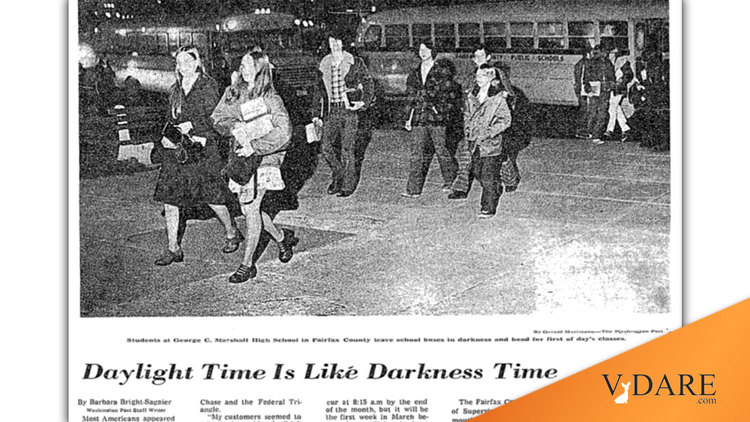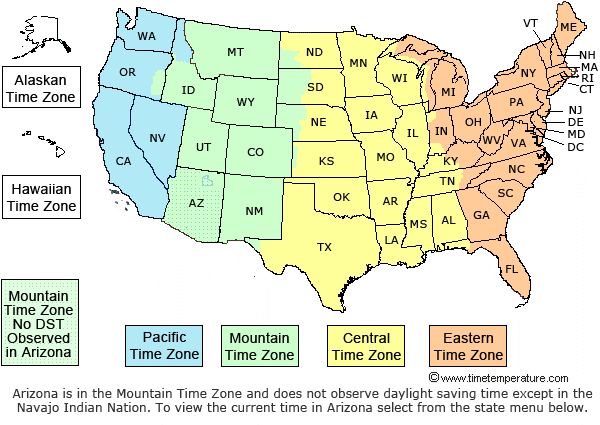Earlier (2021) Daylight Savings Time: A Reform Optimized And Therefore At Risk, Out Of Boredom
As we’ve all been told, it’s terrible that Congress is gridlocked by partisanship, compared to the good old days when wise solons would come together across the chasm of party and make laws for the benefit of all.
Well, it turns out, there is one controversial issue that is, as far as anybody can tell, completely orthogonal to party or the usual identity politics categories: daylight saving time. My guess is that opinions correlate with one identity question—Are you a Morning Person or a Night Person—but nobody has studied if those are politically salient or not.
Other individual differences might depend upon the longitude and latitude you live at. As Countenance blogs, if you live in Terre Haute, Indiana, one of the furthest west outposts of eastern time, making the sun come up and go down exceptionally late year round, you’ve already got all the DST you can handle, thank you very much.
And there are other idiosyncratic reasons people hold whatever views on the subject that they do.
Therefore, neither party is the pocket of the Big Daylight interests (whatever those might be: my parents told me that when Californians voted for DST around 1962, the big opponents were chicken and cow farmers and drive-in movie operators, neither of which make up as big a share of the electorate these days).
So, in this perfect test case of the American republican form of government unencumbered by partisanship, what does the Senate do? It passes, almost without discussion, the one reform—Marco Rubio’s Sunshine Protection Act—that was already tried and failed back in 1974. (I suspect Rubio, a South Floridian, doesn’t feel in his bones how dark and cold winter mornings are in much of the country.) Here’s a photo from the Washington Post on January 8, 1974:
![]()
From Buzzfeed:
Everyone Was Surprised By The Senate Passing Permanent Daylight Saving Time. Especially The Senators.
An inspiring story about how presumptuous Senate staffers can accidentally make history.
by Paul McLeod
BuzzFeed News Reporter
WASHINGTON — The Senate’s unanimous passage of a bill to make daylight saving time permanent stunned many Americans, not least of which the senators themselves.
In a twist the Founding Fathers likely did not anticipate, quirky Senate conventions and a decision by staff in Sen. Tom Cotton’s office may result in an overhaul in the nation’s time zones.
Reporters and politicos were caught off guard Tuesday afternoon when the Sunshine Protection Act sailed through the Senate without issue, with no senators speaking up to object to it passing by unanimous consent. Sen. Kyrsten Sinema, serving as Senate chair overseeing the motion at the time, broke composure, burst into a grin, and whispered, “Yes!”
Senator Sinema is from a rare state without daylight saving, Arizona, where due to a surplus of hot, desiccating sunlight, “Hurry, Sundown” is the state motto.
“I was surprised that someone didn’t object,” she told BuzzFeed News the next day, while noting that Arizona does not change its clocks, “because we’re smart.”
Any single senator could have blocked the daylight saving bill from passing but many didn’t know it was even happening. … Asked to re-create his reaction to the news, Sen. Chris Coons issued a series of shocked stammers that is impossible to phonetically translate.
One Senate source with knowledge of the situation said Sen. Tom Cotton vehemently opposes making daylight saving time permanent.
“No comment,” Cotton told BuzzFeed News when asked if he opposed the bill.
The source said that Cotton would have objected to the unanimous consent request, but his staff never told him it was happening.
… With unanimous agreement, you can do pretty much anything. Any senator can go to the Senate floor any time and ask for unanimous consent to skip all of the debate and the votes and just pass the bill immediately. If no one objects, it is done. But all it takes is a single senator to object and the bill is blocked. …
Senators ask for unanimous consent all the time but it’s usually just for show. The convention is that a senator will first “hotline” their bill, notifying every single senator of their plan. Those senators can then place a “hold” on the bill (saying they refuse consent). …
Other senators, it seems, were not told by their staff that the request was happening.
Coons is one of them. He said that he and some other senators reacted to the news by asking Rubio if they’d given everyone a heads up, and were told yes.
“It’s literally an issue my staff and I had never discussed, and they made an assumption that I don’t really care about daylight saving time,” Coons said. “And I don’t know if I do! I’ve never taken five minutes to stop and think about it.”
If DST were a partisan issue with one party composed of DST fanatics and the other of DST haters, then there’d at least be familiar talking points such at that year-round DST has already been tried and failed. Either Sean Hannity or Rachel Maddow would be trumpeting the fact that Congress imposed year-round daylight saving time in January 1974 in response to the 1973 Energy Crisis, but millions of people hated getting up in the dark in winter, and so Congress went back to the old system in the fall of 1974.
But due to the lack of partisan rancor over this issue, few remember this in any organized fashion, even though tens of millions of voters lived through this experiment. If daylight savings time were a partisan and/or identity politics issue, the 1974 fiasco might be almost as famous as Emmett Till.
I remember the year-round DST experiment vividly because it was formative experience on my career. For some reason, as high school sophomores we got a free subscription to Time magazine. When OPEC raised the price of oil in fall of 1973, Time ran an editorial saying that one obvious no-brainer thing we could do in response was go to year round DST. That made sense to me.
But then, come January, it turned out to be that everybody hated it. So, a few months later, Time ran another editorial denouncing the morons who had passed year-round DST without consulting the Farmers' Almanac on when the sun comes up in winter. A good point, but I could recall, unlike Time’s editors, that Time was one of those morons pushing year-round DST.
And remembering off-narrative facts has pretty much been what I’ve been doing ever since.
![]()
Countenance brings up an issue that I haven’t seen before. If we really shift to year-round daylight savings, we ought to shift the time zones westward. For example, Ontonagon is a town in Michigan’s Upper Peninsula that is one of the furthest points west in the eastern time zone. So its time is shifted very late under the current system. (The sun sets there at 9:55 p.m. in late June under eastern daylight time.)
With year-round DST, the sun would come up on Ontonagon at 9:42 a.m. on Christmas. So, some of the problems of year-round DST could be mitigated by redrawing time zones, generally shifting the borders eastward. Certainly the Upper Peninsula should switch from the Eastern to the Central time zone, and probably all of Michigan.
The late winter sunrise problem is worse in northern states than southern states. North Dakota, for example, might wish to shift entirely into mountain time (currently, its southwestern corner is in mountain time). But Texas, due south of the Dakotas, might wish to stay on central time because the annual swings in time of sunrise are less extreme at lower latitudes.
But, then again, why bother?
[Comment at Unz.com]















